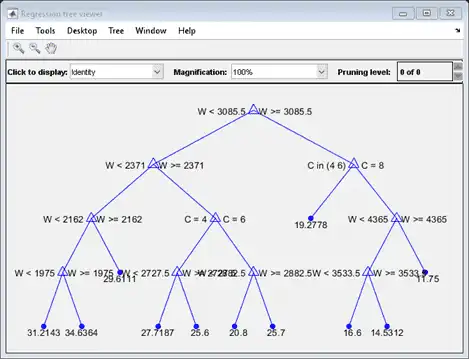Package: classreg.learning.regr
Superclasses: CompactRegressionEnsemble
Ensemble regression
Description
RegressionEnsemble combines a set of trained weak learner models and data on which these learners were trained. It can predict ensemble response for new data by aggregating predictions from its weak learners.
Construction
Create a regression ensemble object using fitrensemble.
Properties
|
|
Bin edges for numeric predictors, specified as a cell array of p numeric vectors, where p is the number of predictors. Each vector includes the bin edges for a numeric predictor. The element in the cell array for a categorical predictor is empty because the software does not bin categorical predictors. The software bins numeric predictors only if you specify the You can reproduce the binned predictor data X = mdl.X; % Predictor data
Xbinned = zeros(size(X));
edges = mdl.BinEdges;
% Find indices of binned predictors.
idxNumeric = find(~cellfun(@isempty,edges));
if iscolumn(idxNumeric)
idxNumeric = idxNumeric';
end
for j = idxNumeric
x = X(:,j);
% Convert x to array if x is a table.
if istable(x)
x = table2array(x);
end
% Group x into bins by using the
Xbinned contains the bin indices, ranging from 1 to the number of bins, for numeric predictors. Xbinned values are 0 for categorical predictors. If X contains NaNs, then the corresponding Xbinned values are NaNs.
|
|
|
Categorical predictor indices, specified as a vector of positive integers. |
|
|
A character vector describing how the ensemble combines learner predictions. |
|
|
Expanded predictor names, stored as a cell array of character vectors. If the model uses encoding for categorical variables, then |
|
|
A numeric array of fit information. The |
|
|
Character vector describing the meaning of the |
|
|
Cell array of character vectors with names of the weak learners in the ensemble. The name of each learner appears just once. For example, if you have an ensemble of 100 trees, |
|
|
Description of the cross-validation optimization of hyperparameters, stored as a
|
|
|
A character vector with the name of the algorithm |
|
|
Parameters used in training |
|
|
Numeric scalar containing the number of observations in the training data. |
|
|
Number of trained learners in the ensemble, a positive scalar. |
|
|
A cell array of names for the predictor variables, in the order in which they appear in |
|
|
A character vector describing the reason |
|
|
A structure containing the result of the |
|
|
A character vector with the name of the response variable |
|
|
Function handle for transforming scores, or character vector representing a built-in transformation function. Add or change a ens.ResponseTransform = @function |
|
|
The trained learners, a cell array of compact regression models. |
|
|
A numeric vector of weights the ensemble assigns to its learners. The ensemble computes predicted response by aggregating weighted predictions from its learners. |
|
|
The scaled |
|
|
The matrix or table of predictor values that trained the ensemble. Each column of |
|
|
The numeric column vector with the same number of rows as |
Object Functions
compact |
Create compact regression ensemble |
crossval |
Cross validate ensemble |
cvshrink |
Cross validate shrinking (pruning) ensemble |
lime |
Local interpretable model-agnostic explanations (LIME) |
loss |
Regression error |
partialDependence |
Compute partial dependence |
plotPartialDependence |
Create partial dependence plot (PDP) and individual conditional expectation (ICE) plots |
predict |
Predict responses using ensemble of regression models |
predictorImportance |
Estimates of predictor importance for regression ensemble |
regularize |
Find weights to minimize resubstitution error plus penalty term |
removeLearners |
Remove members of compact regression ensemble |
resubLoss |
Regression error by resubstitution |
resubPredict |
Predict response of ensemble by resubstitution |
resume |
Resume training ensemble |
shapley |
Shapley values |
shrink |
Prune ensemble |
Copy Semantics
Value. To learn how value classes affect copy operations, see Copying Objects.
Examples
Train Boosted Regression Ensemble
Load the carsmall data set. Consider a model that explains a car's fuel economy (MPG) using its weight (Weight) and number of cylinders (Cylinders).
load carsmall X = [Weight Cylinders]; Y = MPG;
Train a boosted ensemble of 100 regression trees using the LSBoost method. Specify that Cylinders is a categorical variable.
Mdl = fitrensemble(X,Y,'Method','LSBoost',...
'PredictorNames',{'W','C'},'CategoricalPredictors',2)
Mdl =
RegressionEnsemble
PredictorNames: {'W' 'C'}
ResponseName: 'Y'
CategoricalPredictors: 2
ResponseTransform: 'none'
NumObservations: 94
NumTrained: 100
Method: 'LSBoost'
LearnerNames: {'Tree'}
ReasonForTermination: 'Terminated normally after completing the requested number of training cycles.'
FitInfo: [100x1 double]
FitInfoDescription: {2x1 cell}
Regularization: []
Properties, Methods
Mdl is a RegressionEnsemble model object that contains the training data, among other things.
Mdl.Trained is the property that stores a 100-by-1 cell vector of the trained regression trees (CompactRegressionTree model objects) that compose the ensemble.
Plot a graph of the first trained regression tree.
view(Mdl.Trained{1},'Mode','graph')

By default, fitrensemble grows shallow trees for boosted ensembles of trees.
Predict the fuel economy of 4,000 pound cars with 4, 6, and 8 cylinders.
XNew = [4000*ones(3,1) [4; 6; 8]]; mpgNew = predict(Mdl,XNew)
mpgNew = 3×1 19.5926 18.6388 15.4810
Tips
For an ensemble of regression trees, the Trained property contains a cell vector of ens.NumTrained CompactRegressionTree model objects. For a textual or graphical display of tree t in the cell vector, enter
view(ens.Trained{t})